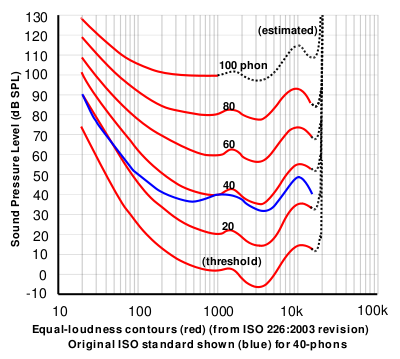Masking Effect
The masking effect is a phenomenon in which the presence of one sound (the masker) can reduce the audibility of another sound (the masked sound).
In acoustics, this effect is particularly relevant in the context of low-frequency sounds and distortion audibility.
Key Points:
- Low-frequency masking: When a low-frequency sound is boosted, it can mask higher-frequency sounds. This can lead to a perceived loss of “kick” and a boomy sound.
- Frequency relationship: The masking effect is most pronounced when the masker and masked sounds are close in frequency.
- Intensity: The masking effect is also affected by the intensity of the masker and masked sounds. A louder masker will have a greater masking effect.
- Distortion: The masking effect also explain why higher-order harmonic distortion is more audible than lower-order distortion.
Here is how it mask from a fundamental:

We also need to couple this to ear sensitivity according to frequency and SPL (aka volume level) :

Example:
If you boost the bass in your music system, you may notice that the vocals become less clear. This is because the boosted bass is masking the higher-frequency vocals.
Practical Implications:
The masking effect is an important consideration in audio engineering and music production. It can be used to create specific effects, such as a sense of depth or power. However, it can also be a source of problems, such as a loss of clarity or detail.
To mitigate the masking effect:
- Use EQ to carefully balance the frequencies
- Avoid boosting the bass too much.
- Use compression power to reduce the dynamic range of low frequency when you listen at high SPL and/or increase it at low level.
sources:
- AES - The Masking Effect: https://www.aes.org/e-lib/browse.cfm?elib=200
- Wikipedia - Auditory masking: https://en.wikipedia.org/wiki/Auditory_masking
- Wikipedia - Equal loudness contour: https://en.wikipedia.org/wiki/Equal-loudness_contour